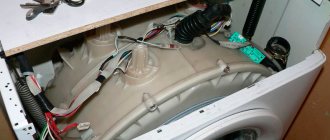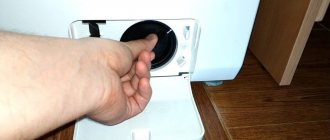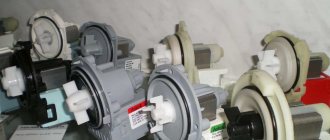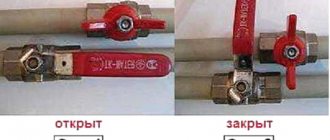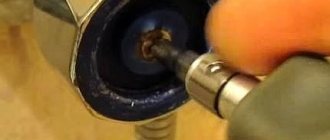Despite the fact that a modern automatic washing machine is a very technologically advanced and complex device, it has key blocks. The most important of them is the drive drum. The correct performance of most washing operations depends on the serviceability of the components of this functional unit. If the washing machine does not spin the drum, it will not be able to start washing and spin out the laundry efficiently, and will completely lose its suitability as a home helper.
The main cause of the malfunction
The drum of washing equipment with vertical loading of laundry most often jams due to the fact that the flaps open during the washing process. The drum of such an automatic washing machine contains two metal doors. They must be closed before washing using a special latch.
Over time, this latch can become loose and wear out. As a result, during the washing process, the latch breaks, the metal flap opens, after which the drum of the machine gets jammed.
Also, the doors sometimes open on working automatic washing machines. This occurs as a result of a mistake by the owner of the equipment. This can happen if you manually rotate the drum while the metal drum doors are open.
If you open the metal flaps and then turn the washing machine drum in such a way that its flaps fall outside the barrier, then you will not be able to turn the washer drum back and open the flaps.
This can happen if the drum is filled with laundry and the flap accidentally gets stuck between the parts of the latch. As a result, the lock of the metal flaps will not be able to close, the metal flaps will open during the washing process and a malfunction will occur.
Take advantage of the Miele brand online store
You are on the Miele brand store website. We sell not only high-quality washing machines from Germany, but also many other home helpers: economical refrigerators and freezers, stylish cooktops and ovens, multifunctional dishwashers and other categories of Miele household appliances. Visitors have access to a convenient catalog with a huge variety of product offerings, which can be grouped using filters. If necessary, our consultants will help resolve any issue you may have by phone or online chat.
All equipment presented in the catalog of the company’s online store has special certificates of conformity and is approved for sale in Russia. All models are 100% original and have an extended manufacturer's warranty of 24 months. The user can order home delivery in Moscow, St. Petersburg and any other locality in Russia.
Repair without disassembling the washing machine
The drum door may open during the washing process or when spinning the laundry. At the same time, its edges break through the protective barrier, after which they rotate in a circle. As a result, the walls of the tank rupture, and the heating element also fails.
This will continue until the electronics forcefully completes the washing process, or the owner disconnects the machine from the power supply after hearing a strong grinding noise.
After this, you need to try to set the drum to its initial position.
There may be difficulties in performing this procedure. When the drum is rotated, the lid will open and catch on the walls of the machine’s tank.
Do not pull the drum too hard. If you rotate the drum carefully, the tank may remain intact. Otherwise, it will definitely be damaged.
In such a situation, it is best to disassemble the machine. After this, get to the metal flaps of the washer drum from the inside and close them. After this, the drum should be returned to its working position.
If the drum flap jams, you must first try to close it without disassembling the washing equipment.
To do this you need to do the following:
The drums of some top-loading machines have a small hole. Then it will be difficult to complete this work. If the machine is not under warranty, you can slightly enlarge one of the holes and then perform the steps described above through it.
If you cannot hook the metal door with wire, you will need to disassemble the machine.
We are trying to repair
How can we begin to talk about repairs? We will do this by first identifying the causes of breakdowns, and then identifying options for their possible elimination. If an imbalance occurs, the most important thing is to stop the washing that has started.
The collected water must be drained. This is done for security reasons. Now you need to open the machine and redistribute the laundry. Things should lie evenly in the drum. If debris has accumulated in the outlet hose, the action plan looks like this:
- open the hatch on the panel below in front.
- take out the filter, get rid of the excess on the filter itself.
- return this element to its place.
To check the drive belt, you need to examine the contents of the machine located behind the rear wall of the case. Arm yourself with a screwdriver, spare parts if necessary, and proceed.
- First, turn off the power to the machine.
- Disconnect the hose, first blocking the flow of water to the washing machine.
- Remove the screws on the back of the cover using a screwdriver.
- Inspect the damage when the panel is removed. Return a frayed or loose belt; if it is too worn, replacement is necessary.
- First, place the belt on the small pulley, and then on the large one, turning it in one direction with one hand.
- Return the wall to its place.
Even if there are problems with the heating element, this situation is not hopeless. In addition, both problems (including those with the motor) can be resolved simultaneously. First you need to unscrew the back cover. The heating element is located under the tank.
After confirming the fault, disconnect the wires from the heating element. Unscrew the central nut, but not all the way, and then press the bolt inward a little. Prying up the edges, pull this element out of the CM. Through the hole that appears, you can examine the interior of the tank for the presence of foreign objects and remove them if necessary.
The heating element for replacement is also installed if you proceed in the reverse order. Before screwing the panel into place, inspect the motor, also located at the back, for any problems. As long as the panel is not screwed down, they can be fixed on site. The next step is to remove the motor to check the brushes and other parts.
- Disconnect the wires connecting the motor to the system.
- Unscrew the fastening bolts.
- Take out the motor and brushes and assess their condition. If the brushes are worn out, they must be replaced, as well as the lamellas and windings.
- Assess the condition of the tachogenerator located next to the engine. It also needs to be replaced if any faults are found.
Repairing washing equipment yourself is a difficult task, but it is at least possible to assess the extent of the damage. Even if you can’t fix it yourself, you can definitely identify your problem with a technician or service center. They will definitely help you there.
Share your opinion - leave a comment
Device repair with disassembly
Many craftsmen are skeptical about the method of closing the drum flap described above. They believe that if the drum jams due to the flap, you should immediately disassemble the machine.
They are partly right, but for a person who does not have experience in disassembling washing equipment, such work may be too difficult.
Next, the general procedure for performing the work will be described, since there are a lot of washing machines with vertical loading of laundry.
You need to do the following:
After removing the wall, you need to pull out the heating element. As a result, a hole is formed through which the shutters can be installed in their initial position.
So, after eliminating the malfunction of the washing machine drum, you do not need to immediately start the washing process.
You need to check the condition of the valves. They should not be deformed. You also need to check the heating element and tank for damage.
Source
The equipment stops after taking in water
Let’s study the “symptoms” of the breakdown as carefully as possible. When you stop the washing machine at the very beginning, you need to check whether it has had time to fill with water. If you have time, then you should drain the liquid through the garbage filter and try to rotate the drum with your hands. If even with your hands the drum turns with difficulty or does not turn, it means that something is preventing the rotation and it is simply jammed. In this situation, we must keep in mind that it is possible:
- the belt came off the drum or broke, and then ended up on the pulley, which blocks the movement of the drum.
- some thing, which was probably previously in the pocket, ended up between the mechanisms.
- the bearing is damaged and does not perform its functions fully. This can happen due to significant loads on the washing machine, when loading an excessive amount of clothing, or if the oil seal was not properly lubricated (manufacturer’s defect).
What to do if your washing machine drum is stuck?
In modern conditions, it is difficult for a person to live comfortably without such a necessary thing in the house as a washing machine. But, sometimes, this hardworking assistant begins to “mope” and refuses to spin the drum. Or it turns, but eerie sounds echo throughout the apartment, haunting everyone in the household.
If your tireless assistant has decided to “go on leave without pay,” you need to find out what prompted her to do so.
First you should find out how easily the washing machine drum spins?
Reasons why the drum does not spin in the washing machine
A home washing machine can break down for several reasons. To find them, you need to determine at what stage the stop occurred. Based on this, the issue of repair is decided. Before self-diagnosis, you should perform several steps:
Foreign object
Torn items of clothing or forgotten items from pockets sometimes end up in the space between the drums and the tank where the heating element is located. Everything that gets there sinks to the bottom, winds up on the shaft (if flexible and long) or gets stuck between the walls. In this case, an obstacle to rotation is created and the drum stops.
If a foreign object partially protrudes into the drum, it can be removed without disassembling the machine. Otherwise you will have to remove the heating element. Shine a flashlight into the opened hole to find the source of the stop. Using a wire hook, the object is removed.
Bearing jammed
The rotation of the drum may stop due to wear of the support bearing. Depending on the design of the washing machine, there may be one or two of these elements. After long-term use, worn out oil seals begin to leak water, corrosion occurs and the bearing jams. The problem is solved by completely replacing worn out elements. To do this, you need to have certain skills or contact a repair shop.
The belt drive has fallen off or broken
The transmission of rotation from the electric motor to the drum is carried out using a belt drive. A belt breaking or slipping off the pulleys disrupts the connection between the elements. In this case, the drum rotates freely by hand, and the motor hums when voltage is applied. To fix it you need to get to the engine and large pulley. Washing machines use V-belts or poly-V-belts. To install, you need to loosen the engine mount and ensure that the grooves of the mating parts match.
Engine failure
An electric motor is a fairly reliable unit, but it can also stop. Main reasons for refusal:
Electric motor commutator brushes are made from carbon powder. To ensure good contact, they are pressed with special springs. During operation, the brush material wears out and their length decreases. At some point the size becomes minimal and contact is broken. The malfunction can be easily eliminated by replacing worn out elements.
When the winding turns are closed, the drum can move without load, but during washing the network protection against short circuit will work. When the engine is turned on, it will hum but not spin.
A broken winding or interruption in the power supply will also cause the motor and drum to stop. The last reason for failure is the most harmless, as it can be eliminated by restoring contacts. All others will require removal of the electric motor and its inspection. In some cases, repairs in specialized workshops or complete replacement of the engine will be required.
Control module malfunction
The control module is the electronic “brain” of the washing machine. If it does not issue the appropriate commands, the unit will not work. Electronics fail for several reasons:
Initially, you should try to reset the programs. Some washing machine models have a self-test function; by running it, you can determine the cause of the problem. If performance is not restored, removal and diagnostics of the electronic unit will be required. To repair it you need to have specialized knowledge.
The flaps in the vertical washing machine opened
Occasionally, the drum of vertical washing machines stops due to the opening of the loading doors. It's good if the car stops immediately. Otherwise, the heating element, the walls of the tank and the doors themselves are damaged.
After stopping, you can try to turn the drum by hand until the loading hatch appears. If that doesn’t work, try to hook or close the doors with a wire hook, pushing them through the holes and lighting them with a flashlight. In extreme cases, you will have to disassemble the tank, provided that it is collapsible.
Overload
All household washing machines are designed for a certain weight of loaded laundry. Exceeding this parameter leads to premature wear of the mechanical components of the unit. Many manufacturers have taken care of the durability of their washing machines and installed special sensors in them, which, if loaded incorrectly, give signals to stop. The corresponding error code is displayed on the display. Further starting is possible after removing excess laundry from the drum.
Failure options
The machine draws water for washing, but does not spin the drum
There are dozens of reasons for the situation when the washing machine will draw water into the tank to start the washing process, but will not be able to spin the drum. First of all, you should manually check whether the drum is spinning.
If it is easy to unwind by hand, then most likely the problem is either electronic or a broken or falling off motor drive belt. If it becomes worn, torn or stretched, it should be completely replaced with a similar one.
Drum does not spin during spin cycle
The washing machine drum may not spin during the spin cycle for several reasons:
- The washing program is set to “No spin” or “Delicate wash”. In this case, spinning will either not be carried out at all, or the minimum number of revolutions will be set so as not to stretch things.
- If the drain is clogged, the water will not be able to leave the tank and the electronic control unit of the machine will not start the spin cycle.
- If the water quantity sensor is faulty.
- There may be problems with the electronics and wiring of the control board.
Drum stopped during washing
The washing machine may stop the washing process if a lot of items have accumulated on one side of the drum. In this case, when there is an imbalance, strong vibrations occur.
At the same time, the electronic control unit gives a signal to stop washing, since an imbalance can lead to mechanical damage to the elements of the device and serious breakdowns.
Clogged hoses or a breakdown of the water level sensor in the tank can also cause the washing process to stop.
Always pay attention to the display - modern cars display error codes on it.
Washing cannot proceed without heating the water, so if the heating element malfunctions, the temperature sensor will give a signal to stop washing and the drum will stop along with the laundry. Touch the glass of the door: if it is cold, although the heating cycle is selected, then there is a problem with the heating element, most likely it will have to be replaced.
The same is true in the opposite situation - if the water temperature sensor is faulty, then the washing will be completed, since the control unit cannot monitor the current state and, accordingly, give a signal to continue working.
The motor hums, but the drum does not rotate
In a situation where the washing machine motor is running, but the tank does not turn, the cause may be jamming or mechanical damage to the device.
But the most common cause of this phenomenon is defects in the electric motor drive belt. It may tear or come off the pulley. In the worst of all cases - when it breaks, it wraps around the motor shaft, tearing it even more, which can cause damage to other elements.
If foreign objects get into the space between the tank and the drum, rotation may be difficult or completely blocked.
If the heating element or thermostat is damaged, the corresponding signals from the components of the washing machine do not reach the software control board, which leads to the drum not starting to rotate, although the motor is working.
The drum does not turn manually, it is jammed
There are several main reasons for a completely jammed washing machine drum: problems with the motor drive belt, problems with the bearing, and foreign matter entering the space between the tub and the drum through the rubber seal.
First of all, the bearing wedge is best diagnosed by related signs: it degrades for a long time, so unexpected failure is rare. Most often, for a long time the bearing will interfere with a strong grinding and humming noise when the machine is operating. It is also possible that the drum may have some play, and it will seem to rotate with force.
After this, at one point the drum will be completely immobilized, and it will also be impossible to turn it by hand. The reason may be either degradation of the bearing with subsequent failure, or its complete destruction. The second case will be accompanied by strong noise during the last washes before the breakdown.
DIY repair
If the washing machine drum does not spin during washing, you can try to fix it yourself. However, devices from different manufacturers differ from each other in some design features and technologies used. Therefore, the repair sequence depends on the model of the washing machine.
Indesit
Let's look at an example of repair using the horizontal loading model WIXL83. If the drum does not spin when the Indesit washing machine is turned on, you should immediately check the belt drive and motor. To repair, the washing machine is unplugged, turned around and leaned on something so that the back wall is free. Next, unscrew the screws securing the oblong hatch, behind which there is a belt drive and an electric motor.
If the belt is intact, then you need to check the motor brushes. Power may not be supplied due to worn brushes or a dirty commutator. The electric motor is secured with two bolts; before unscrewing them, the block with wires is first disconnected. After removal, you can check the length of the brushes and the condition of the commutator. The latter, if necessary, is cleaned to a metallic shine. Short brushes are replaced with new ones.
Samsung
Possible reasons for the drum stopping on a Samsung washing machine are similar to other models. When replacing brushes, you need to make sure that they move freely in the brush holders. Sometimes, due to accumulated contaminants, the forces of the springs are not enough, and the contact is broken. When the electric motor operates, coal dust gets into the gaps and the brushes jam. The problem is solved by removing the brush holders and cleaning the holes.
Another reason for stopping the electric motor is a breakdown of the tachometer located on the rotor. It records the engine speed and transmits information to the electronic control unit. In appearance, the knot looks like a small metal ring, sometimes covered with a plastic casing. There are 2 small diameter wires coming from it.
The tachometer is checked with a multimeter (tester) in ringing mode. The wires are connected to the device and the rotor of the electric motor is rotated by hand. If the sensor is working properly, the multimeter will make short sounds (the needle oscillates). Otherwise, replacement will be required.
In an LG washing machine equipped with a direct drive from an inverter motor, the drum does not spin or jerks slightly due to a broken Hall sensor. When you try to turn it on, a whistling sound is made.
To access the engine, you need to disconnect the unit from the mains and remove the back cover, which is held on by four self-tapping screws. Next, unscrew the central engine bolt. To do this, you will have to fix the rotor. A screwdriver is inserted obliquely into the upper vertical slot of the protective disk and pressed against the head of the hidden bolt. Then unscrew the 6 fasteners of the disk with coils and remove it.
On the back side of the removed element there is a Hall sensor. It is fixed with plastic latches, and the connector is disconnected before dismantling. Use a knife or flat screwdriver to pry up the fasteners and the sensor is easily released. Having replaced the damaged element, everything is assembled in the reverse order.
Bosch
When the drum stops in the Bosch Maxx 5 washing machine, error F21 appears on the display. The machine does not carry out the program and does not fill with water. First, after disconnecting from the network, you need to check with your hand the free rotation of the drum. If everything is in order, inspect the belt drive. Access is via the rear hatch.
If the belt is intact, you need to remove and check the electric motor. To do this, perform the following steps:
The tachometer is checked by ringing with a multimeter. If it is in good working order, you need to remove the brushes and replace them if necessary. The sequence of disassembly and assembly of the Bosch Max 4 and some other models in this series is similar.
The main reason the Beko washing machine drum stops is wear on the brushes of the commutator motor. When turned on, the machine draws water, and then stops showing signs of life. The algorithm of actions for replacing them is standard, but there are some features. Access to the engine is through the rear hatch. By unscrewing the screws and removing it, you can inspect the internal mechanism.
Before removing the engine, you need to release the transmission belt and disconnect the block with wires. The electric motor housing is secured with two bolts with heads that have sprocket cutouts; to unscrew them you will need a T40 socket.
The brushes are inserted into special holders, which are secured to the motor housing with screws.
After replacing the worn elements, everything is reassembled in the reverse order.
Zanussi
Replacing brushes in a Zanussi washing machine is not difficult. But you won’t be able to get to the engine through the rear wall. To implement your plan, you need to place the machine on the floor face up. From below there is access to the motor. It is not necessary to remove it. The brush holders are fixed with self-tapping screws; they are removed after first unscrewing their fasteners and disconnecting the connectors.
The lack of contacts may be due to wear, jamming of the brushes in the guides, or contamination of the armature with coal dust or burning. All causes must be checked and eliminated. The plastic brush holder is disassembled into two halves and the metal guides and brush are removed from there. If you don’t have the part you need for this particular model, you can look for a replacement. It is enough to select brushes of suitable sizes from other units, you just have to solder the wires.
Electrolux
The Electrolux dryer also has a drum, which due to malfunctions one day refuses to spin. The main reason for this problem is wear of the support rollers on the engine or housing. The problem is solved by replacing them. To access the internal mechanisms, remove the side walls and top.
The engine is not removed, but only the tension spring on it is unhooked with pliers. After this, the entire assembly can rotate freely. Next, the old video is removed and a new one is installed in its place. The compressor housing interferes with these manipulations, so it will have to be tilted slightly. Before installation, the shaft is lubricated. Then I set the belt straight and put it on the engine. The drum is rolled by hand several times to obtain the parts of the working position. At the end, fix the tension spring and secure the side walls.
"Ariston"
In addition to the listed reasons for the drum not rotating in washing machines, there are unusual cases. One of them is broken wires. This sometimes happens after inattentive self-repair after removing the engine or drum.
In the Ariston washing machine, the electronic unit is located on the rear wall at the bottom left. The blocks with wires are connected from the inside and directed inward. When performing any manipulations or moving large components, an unintentional impact on these elements is possible. As a result, the pads are crushed or the wires are torn off. Moreover, the gap may not be visible, but there is no contact.
Therefore, before repairing the electronic unit, you should carefully check the integrity of the connections with the device; perhaps the malfunction occurred due to missing contacts. Please note that the connecting blocks are made of thin plastic and disassembly must be done carefully.
A malfunction occurs when a full drum tries to turn during washing, but cannot, spinning does not occur. It feels like there is not enough power. This is typical for washing machines with asynchronous motors, such as Ardo. Power loss occurs due to a decrease in the capacity of the starting capacitor.
If you open the back wall of the Ardo washing machine, the part you are looking for can be found at the top right above the drum. Using a 12 mm socket, unscrew the fixing nut and remove the capacitor. The failed part must be replaced with a similar one. Ardo has a 16 mF capacitor. If you install an element with a larger capacity, the engine will overheat, if you install a smaller one, the power will be lost.
Design features of different manufacturers
Before you begin repairing household appliances using the algorithms given earlier, you must take into account that each washing machine has its own design features.
LG
LG household appliances use direct drive. But, despite this design feature, washing machines produced by this company break down, mainly due to the above reasons. It is also recommended to check the condition of the hall sensor during diagnostics.
Ariston
For Ariston equipment, the area of attachment to the tank is considered weak. Therefore, breakdowns of devices of this brand mainly occur due to the use of hard water or improper installation.
Samsung
The design of the latest Samsung models includes powerful magnets that ensure torsion of the drum. And the breakdown of this part is also one of the reasons for the failure of household appliances and the occurrence of the problem in question.
Indesit
Indesit brand devices are characterized by a standard design. The difference between the models of this manufacturer mainly lies in the operation of the built-in electronics and the size of the drum. Therefore, owners of Indesit devices usually encounter the previously described breakdowns.
Beko
Structurally, Beko washing machines do not differ from similar devices of other brands. The difference between such devices is that household appliances from this manufacturer are equipped with parts made of more durable materials and an asynchronous inverter motor. This configuration extends the service life of the devices, but increases the cost of maintenance in case of breakdown.
Bosch
Bosch brand devices use drums of different designs, which must be taken into account when disassembling the devices.
